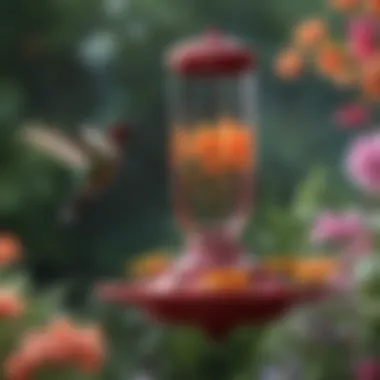Effective Strategies to Keep Bees Away from Hummingbird Feeders


Intro
Hummingbird feeders provide an essential source of nourishment for these delicate birds, attracting them to gardens and outdoor spaces. However, a common challenge many homeowners encounter is the presence of bees, which can overwhelm these feeders, creating a less inviting atmosphere for the birds. Understanding the intricate relationship between bees and hummingbirds is vital for successfully managing this issue.
Design Insights
Selecting the Right Feeder
Choosing an effective hummingbird feeder design is crucial. Different types of feeders can deter bees naturally. Look for feeders with feeding ports that are specifically engineered to accommodate the smaller beaks of hummingbirds, while restricting larger insects such as bees.
- Top Feeders: These feeders have a design where nectar is accessed from the top, making it less accessible to bees.
- Upside-down Feeders: This style limits access to bees and gives hummingbirds an advantage in feeding.
Placement Strategies
The placement of the feeder plays a significant role in attracting the right winged visitors. Keep feeders away from flowering plants that produce the same color as the feeder. Ensure that feeders are stationed in open spaces instead of areas dense with flowers. Such positioning reduces bees' natural tendency to investigate.
Color Considerations
The color of the hummingbird feeder can also affect its attraction level. Hummingbirds are drawn to bright colors. However, certain shades, particularly orange and yellow, can attract bees. Therefore, consider using red or pink in the feeder design while avoiding yellow, which may beckon bees.
Practical Solutions
Several methods and solutions exist that can help in keeping bees at bay without harming hummingbirds.
- Bee Guards: Installing bee guards can reduce bees' access to nectar without obstructing hummingbirds.
- Creating a Bee-Safe Area: Designate a specific area for flowers that attract bees, drawing them away from the feeders. Examples of plants to consider include lavender and borage.
- Schedule Feedings: Hummingbirds are often most active during specific periods of the day. By adjusting feeding times to align with hummingbird activity, you can minimize bee presence.
“Understanding the habits and preferences of both bees and hummingbirds enables homeowners to create an environment that favors hummingbirds while keeping bees away.”
Understanding the Relationship Between Bees and Hummingbirds
The relationship between bees and hummingbirds offers insights into the complexities of the ecosystem. Understanding this relationship enriches our knowledge of how different species interact within their environment. Bees and hummingbirds both play crucial roles in pollination, yet their interactions can lead to competition, particularly when it comes to accessing nectar from feeders.
Ecological Roles
Bees function as pollinators, aiding in the reproduction of many plants. Their presence is vital for maintaining biodiversity and contributing to food production. Hummingbirds, on the other hand, also serve as effective pollinators, relying on nectar as their primary food source. They visit flowers and, through their feeding, facilitate the transfer of pollen, supporting plant growth and reproduction. Each species supports the other, creating a delicate balance within their habitat.
Bees generally do not harm hummingbirds, yet their competition for nectar can lead to conflicts. Homeowners often observe bees dominating feeders, which can discourage hummingbirds from visiting. This scenario can lead to decreased hummingbird populations, affecting local ecosystems and biodiversity.
Both insects and birds have adapted to share their nectar resources, demonstrating the remarkable interplay of competition and cooperation found in nature. However, it’s essential to note that understanding these roles helps us appreciate the importance of creating an inviting atmosphere for hummingbirds while managing bee populations around feeders.
Nectar Sources
Nectar serves as a fundamental energy source for both bees and hummingbirds. They are drawn to flowers based on nectar availability and accessibility. Nectar-rich flower species, like trumpet vine or bee balm, not only attract nectar lovers but also influence where these pollinators will feed.
For hummingbirds, specific feeder designs can imitate the natural nectar sources they prefer. However, this can also inadvertently attract bees. When designing hummingbird feeders, consider incorporating features that make it more challenging for bees to access the nectar. This can include narrower feeding ports that only allow hummingbirds to drink comfortably.
Additionally, nectar's sugar concentration plays a role in attracting both species. Highly concentrated solutions may be more appealing to bees, which can lead to increased competition at feeders. To mitigate this, some homeowners may opt to dilute the nectar slightly, keeping it enticing for hummingbirds while reducing bee attraction.
Fostering a clear understanding of the interactions and dietary preferences of these creatures paves the way for practical strategies in managing feeders effectively, ensuring a hospitable environment for hummingbirds.
Why Bees Are Drawn to Hummingbird Feeders
The interaction between bees and hummingbird feeders represents a complex ecological scenario. Understanding why bees are attracted to these feeders is crucial for hummingbird enthusiasts looking to create a suitable feeding environment. Recognizing the factors that pull bees towards these sugar sources contributes to formulating effective deterrent strategies. The information provided in this article not only serves to enhance the feeding experience of hummingbirds but also aims at safeguarding local bee populations.
Sweet Solutions
Hummingbird feeders are generally filled with a sugar-water solution. This sweet concoction mimics the high sugar content found in natural nectar, which is what bees primarily seek. The attractiveness of sugar is a fundamental characteristic of many pollinators, including bees. They are drawn to sweetness as it provides the energy required for their foraging activities. Hence the attraction to hummingbird feeders is not coincidental. It becomes vital for homeowners to acknowledge that altering the sugar concentration in feeders may influence bee visitation.
Several strategies can be employed to manipulate feeder designs. For instance, incorporating feeder designs that limit access to sugar solutions will shift the interest back to hummingbirds and away from bees. Examining how to dilute the appeal of sugar can be part of a systematic approach for keeping bees at bay. It is worth noting that while bees primarily feed on nectar, they also require water, making it essential to consider all aspects of their attraction.
Attractants in Feeders
Another compelling reason bees are attracted to hummingbird feeders centers on the design and functionality of these feeders. The colors, shapes, and placement of feeders can significantly influence bee activity. Bright colors, such as red, are known to draw not only hummingbirds but also bees. The visual stimuli play a crucial role in guiding these pollinators toward the feeders.
Moreover, the type of feeder material may also affect bees' interest. Nectar may seep from old or poorly designed feeders, creating an irresistible incentive for bees. Regular maintenance is, therefore, imperative. Keeping feeders clean and ensuring that nectar does not leak significantly reduces their appeal to bees. Moreover, ensuring that the feed is fresh without fermented remnants will further deter bees while still providing nourishment to the hummingbirds.
In summary, understanding the factors underlying the attraction of bees to hummingbird feeders can lead to more effective management of these populations while fostering a welcoming feeding environment for hummingbirds.
The Impact of Bees on Hummingbird Feeding
The interaction between bees and hummingbirds at feeders is critical to understand for anyone interested in creating a thriving avian habitat. Bees, while beneficial pollinators, can disrupt the feeding behavior of hummingbirds. This section explores the competition for resources and the behavioral changes triggered by this interaction, highlighting key aspects that are essential to maximizing hummingbird visits.
Competition for Resources
Bees are naturally attracted to sweet substances, and hummingbird feeders often present a rich source of nectar. When bees invade these feeders, they create a significant competition for food. This competition can limit the feeding opportunities for hummingbirds, especially during peak feeding times. Hummingbirds have high metabolic rates and need a reliable source of nectar to sustain their energy levels.
If bees dominate the feeder, it can result in decreased visitation from hummingbirds. This, in turn, impacts their overall health and ability to thrive. The presence of bees may also discourage different species of hummingbirds from visiting. Therefore, it is essential for homeowners to implement strategies that reduce bee presence at feeders.
Behavioral Changes
The presence of bees can alter hummingbird behavior in noticeable ways. Hummingbirds may exhibit stress or wariness when bees are around. They are agile flyers but may avoid a feeder occupied by bees. This wariness might lead them to seek out alternative food sources, which may be less optimal or harder to find. Additionally, stress from competing with bees can affect a hummingbird's feeding efficiency and their ability to build necessary fat reserves for migration.
To mitigate these behavioral changes, it is crucial to create a hummingbird-friendly environment that minimizes bee presence.
"Understanding the dynamics between bees and hummingbirds is vital in creating a suitable feeding environment for both."
Achieving a balance where hummingbirds can thrive without the interference of bees is both an art and a science. Homeowners must observe and react to the situation, making necessary adjustments to protect their delicate visitors.
Design Strategies for Deterring Bees


In order to create an enjoyable space for hummingbirds, it is essential to consider design strategies that can effectively deter bees. Understanding the intricacies of feeder design can play a crucial role in maintaining a bee-free environment. A well-designed feeder not only attracts hummingbirds but also minimizes the likelihood of bees intruding. These strategies focus on both the physical features of the feeders and their overall placement in the garden or yard.
The importance of these design strategies can be summed up in several key points. First, they help maintain the delicate balance between attracting hummingbirds and keeping bees at bay. Second, they allow for better resource management, ensuring that the sugars intended for hummingbirds do not attract unwanted pests. Lastly, through thoughtful design, it’s possible to enhance the aesthetic appeal of your outdoor space while benefiting local wildlife.
Imagine a scenario where a beautifully designed feeder caters only to the desired guests—hummingbirds—without the disturbance from bees. Proper design considerations can transform your garden into a haven for these avian creatures, enabling them to feed without competition from bees. This section will explore specific elements of feeder design and strategic placement to illustrate how homeowners can achieve this balance.
Feeder Design Considerations
When selecting a feeder, there are several aspects that should be taken into account to make it less appealing to bees. A few of these considerations include:
- Feeder shape: Opt for feeders with narrow feeding ports, as wider openings often invite bees. Maintaining small feeding ports will ensure only smaller birds, such as hummingbirds, can access the nectar.
- Color choices: Select colors that are favored by hummingbirds. Bright reds, pinks, and oranges attract these birds, while less vibrant colors can deter bees.
- Material and construction: Choose feeders made from materials that are not conducive to bee attraction. Plastic or glass feeders with sleek designs can aid in preventing bees from landing easily.
- Nectar design: Using nectar formulas with specific qualities may help. For example, consider recipes with high water content that are less appealing to bees.
Implementing these feeder design considerations is vital for ensuring successful hummingbird feeding, free from bee interruptions.
Placement and Positioning
Beyond design, the location of the feeder plays a significant role in keeping bees away. Here are some strategies for successful placement:
- Distance from flowering plants: Place feeders at least ten feet away from flowers, particularly those favored by bees. This distance can help to create a barrier that reduces bee interaction with the feeders.
- Vertical height: Position feeders at a higher elevation, if possible. Hummingbirds tend to have a natural inclination to feed in elevated areas, whereas bees may prefer lower vegetation.
- Avoidance of sunlight: Keep feeders in areas that receive less sun, as bees are often attracted to warm, sunny spots. Choosing partially shaded areas can discourage bees while providing a comfortable environment for hummingbirds.
- Windy locations: Placing feeders in slightly windy spots can also be beneficial. Wind can deter the more delicate bees from visiting your area, while hummingbirds are agile flyers who can navigate breezy conditions with ease.
Evaluating both feeder design and the strategic positioning of the feeders will create a healthier feeding environment while ensuring a focus on hummingbirds. Efforts to balance aesthetics and functionality lead to a successful outdoor setup.
"Good design is about making choices that enhance the experience for both the user and the environment."
By applying these design strategies, homeowners can effectively manage the presence of bees at hummingbird feeders, promoting a thriving habitat for their feathered visitors.
Alternative Feeding Solutions
In the quest to create a hummingbird-friendly environment, finding alternative feeding solutions is crucial. These strategies not only provide options for sustaining hummingbirds but also help minimize the presence of bees at feeders. By understanding the different types of feeders and sources of nectar available, homeowners can determine the best approach to cater to their avian visitors without attracting bees.
Bee-Proof Feeders
Bee-proof feeders are specifically designed to minimize bee access while allowing hummingbirds to feed freely. These feeders often incorporate various features that deter bees. Some design aspects to consider include:
- Nectar Access: Feeders should have feeding ports that are small enough to prevent bees from reaching the nectar.
- Shaded Locations: Keeping feeders in shaded areas can help, as bees tend to prefer open, sunlit spaces.
- Nectar Composition: A less sugary nectar solution can make it less attractive to bees while still being appealing to hummingbirds. A common mix is four parts water to one part sugar, but slightly reducing the sugar content may help.
- Feeder Types: Look for feeders with built-in bee guards or other specific bee-repelling mechanisms that can provide additional protection for the nectar source.
By incorporating these design considerations, homeowners can enjoy the beauty of hummingbirds without undue competition from bees.
Natural Nectar Sources
In addition to artificial feeders, natural nectar sources can be an effective means of attracting hummingbirds while minimizing competition from bees. Planting native flora that produces nectar can create a more inviting environment for hummingbirds. Some important points to consider include:
- Choosing the Right Plants: Select flowers that are known to attract hummingbirds, such as Bee Balm, Salvia, and Hummingbird Sage. These plants provide nectar without drawing in excessive bee activity.
- Nectar-Rich Plants: Ensure that the plants you choose have deep tubes or are shaped in a way that suits hummingbirds but is less accessible to bees.
- Continuous Blooming: Plant a variety of flowers that bloom at different times throughout the season. This ensures a consistent supply of nectar and can help to balance the number of available feeding stations for both hummingbirds and bees.
- Garden Placement: Design the garden layout to have areas for hummingbirds that are separate from areas likely to draw bees. This can involve strategic placement of feeders versus plantings.
Utilizing bee-proof feeders alongside natural nectar sources creates a balanced approach that attracts and nurtures hummingbirds while keeping bees at bay. Through thoughtful planning and execution, homeowners can sustain their feathered visitors in an environment that is conducive to both their enjoyment and comfort.
Chemical and Natural Deterrents
Understanding the role of chemical and natural deterrents is crucial in managing the presence of bees around hummingbird feeders. These methods can either repel bees or create a more inviting atmosphere for hummingbirds. By employing the right strategies, homeowners can ensure their feeders attract the desired avian visitors while minimizing interference from bees.
Chemical Repellents
Chemical repellents are substances specifically designed to deter bees from approaching certain areas. Their effectiveness is often reliant on specific properties that bees find unpleasant. Common chemical options include essential oils like peppermint, eucalyptus, and citronella. These can be found in both commercial bee-repellent products and homemade solutions, offering flexibility in approach.
When using chemical repellents, it is important to consider the impact on both bees and hummingbirds. Some repellents can be harmful to beneficial pollinators. Therefore, it is advisable to apply these substances in a way that minimizes exposure to nectar sources.
- Targeted Application: Spray around the area without applying directly to feeders. This limits contact with the hummingbirds.
- Frequency of Use: Overuse can decrease the effectiveness of repellents, as bees may become accustomed to them. Regular reapplication is necessary but should be done carefully.
Natural Remedies
Natural remedies are often favored for their environmentally friendly properties and lower risk to beneficial insects. These can range from the simple use of vinegar and water to more complex herbal concoctions. Such options not only repel bees but also avoid unwanted chemical residues in the garden.
Some effective natural remedies include:
- Vinegar and Water: This mixture can be sprayed around feeders to create a barrier that bees dislike.
- Cucumber Slices: Placing cucumber peels near feeders may keep bees away due to their natural scent.
- Garlic Spray: A blend of garlic and water can act as a deterrent while being safe for hummingbirds.
"Natural solutions often provide homeowners a peace of mind, knowing they are protecting their garden without harming the ecosystem."
Using these deterrents thoughtfully can lead to a more enjoyable feeding environment for hummingbirds. Evaluating their effectiveness requires observation, as individual results may vary significantly depending on local bee populations and environmental variables.
In summary, chemical and natural deterrents play a vital role in protecting hummingbird feeders from bees. Homeowners should carefully select and apply these methods to maintain a balance in their gardens.
Behavioral Modifications for Homeowners
Understanding the impact of behavioral modifications can greatly enhance the experience of feeding hummingbirds while reducing bee interference. This section explores essential strategies that homeowners can employ. Adjustments in feeding techniques and maintenance habits can play a pivotal role in keeping the bee population at bay without compromising the availability of nectar for hummingbirds. Applying these methods is not just about reducing competition. It also fosters a healthier feeding environment for avian visitors.
Feeding Schedule Adjustments
One effective way to keep bees from dominating hummingbird feeders is to modify feeding schedules. Timing the availability of nectar is key. For instance, filling feeders in the early morning or late afternoon can help. During these times, bees are less active. Hummingbirds tend to be more active than bees, which means there is a higher chance for these birds to feed with fewer interruptions.
It is also advisable to change the frequency of refills. Instead of replenishing nectar every day, consider doing so every other day. This method encourages hummingbirds to feed more efficiently while minimizing the time that nectar sits in the feeder, which can attract more bees. Additionally, you may want to observe local bee activity patterns and adjust feeding periods according to peak times. Recognizing when bees are most present can lead to smarter refilling schedules.
Regular Cleaning Practices
Cleaning the feeders regularly is essential for maintaining a pristine feeding environment. Bees are often attracted to sugary residues, which can accumulate if feeders are not cleaned frequently. It is recommended to clean feeders every two weeks. Use hot, soapy water, and ensure all residues are thoroughly removed. Additionally, a 1:1 vinegar and water solution can effectively sanitize feeders. Also, rinse all parts with clear water to eliminate any soap or vinegar traces.
Feeder placement also plays into cleanliness. Keeping feeders away from blooming flowers, which produce sugary nectar, can reduce contamination from bees. Furthermore, consider rotating feeder locations periodically. This change can disrupt bee patterns over time, leading to less consistent visits to certain feeding sites.
"A clean feeder not only benefits the hummingbirds but also acts as a deterrent for bees. Regular upkeep is crucial for a successful feeding environment."


By integrating schedule adjustments and cleaning practices into daily routines, homeowners can significantly reduce the chance of bees overpowering hummingbird feeders. Such behavioral modifications do not just serve one purpose; they enhance the overall feeding experience for both hummingbirds and homeowners.
Seasonal Strategies for Hummingbird Feeding
Seasonal strategies for hummingbird feeding are integral to ensuring that these birds thrive in your yard without the interference of bees. Understanding the timing of nectar availability and adjusting feeder use according to migration patterns can significantly improve the experience for both the hummingbirds and the homeowners.
Seasonal Nectar Availability
Nectar availability fluctuates throughout the year, influenced by climate and local flora. During spring and summer, many flowering plants provide rich nectar sources. It's crucial to correlate when your hummingbird feeders offer nectar with times when natural sources are abundant. The key is to recognize peak blooming seasons in your area.
- Regional considerations: Different regions experience flowering at varying times. For example, areas in the southern U.S. may see blooms as early as March, while northern regions might not have flowers until May.
- Feeder maintenance: Keeping feeders clean and filled ensures that if natural nectar is scant, birds have a reliable source.
Given that bees also proliferate in warmer seasons, understanding seasonal changes helps in devising effective deterrence strategies that align with natural patterns. Regularly checking flowering plants in your vicinity can also inform the best times to modify feeder placements or designs to discourage bee activity.
Timing Feeders for Migration
Migration periods for hummingbirds occur typically in spring and fall. During these times, hummingbirds travel significant distances, and many will stop frequently to refuel. Thus, having feeders readily available is essential.
- Spring migration: In many locations, this starts in the early months of the year, often around March. Setting up feeders before this time creates a welcoming environment for arriving birds.
- Fall migration: Typically occurs from August through October. Reducing or removing feeders during this time can help deter bees, which are more active in late summer.
- Adjusting feeder schedules: Maintain feeders at a constant schedule to ensure they remain stocked during high-traffic periods. If bees swarm, consider temporarily removing feeders or using designs that specifically keep bees out.
"Understanding timing allows for both the welcoming of hummingbirds and the reduction of bees, striking a balance that benefits all parties involved."
In summary, implementing seasonal strategies involves careful observation of environmental cues and adapting feeder use accordingly. By providing effective feeding options that align with hummingbird migratory patterns while minimizing bee attractions, you can create a more pleasant space for nature lovers.
Observational Techniques
Observational techniques are essential when it comes to effectively managing bee activity around hummingbird feeders. By observing the environment, individuals can gain important insights into the behavioral patterns of both bees and hummingbirds. Understanding these patterns is crucial for developing strategies that minimize interference from bees while still welcoming hummingbird visits.
Monitoring Bee Activity
Monitoring bee activity is the first step in maintaining a bee-free feeding area. This involves regular observation of the feeder, noting the times when bees are most active and the types of bees present. Keeping a journal can be helpful in tracking these observations over time. By identifying peak activity periods, you can adjust feeding times or design modifications to reduce the chances of bee interactions.
Considerations for effective monitoring include:
- Feeding Times: Observe if particular times of day attract more bees. Post-sunset or early morning or late afternoon could be more favorable for hummingbirds.
- Weather Conditions: Bees are more active when it is warm and sunny. Colder or overcast days may deter them, showing a clear advantage for timing your feeding.
- Area Proximity: Assess if any nearby flowering plants are attracting bees. Keeping your feeder away from their preferred nectar sources can make a significant difference.
By monitoring these factors, you can identify patterns that will inform your approach to feeding hummingbirds.
Adjusting Approaches Based on Findings
Once you have monitored bee activity, it is vital to adjust your strategies based on your findings. Flexibility in your methodology can result in a more effective feeding environment. For instance, if you find that bees swarm the feeder during specific times, consider altering your feeding schedule to avoid those periods. Here are some adjustments to consider:
- Change Feeder Placement: If bees are consistently attracted to your feeder, try relocating it away from areas with high bee activity or blooming flowers. A more secluded spot can be beneficial.
- Use Bee-Proof Feeders: After identifying the types of bees frequenting your feeders, you might want to explore bee-proof options that prevent them from accessing the nectar while still allowing hummingbirds to feed.
- Experiment with Nectar Composition: Sometimes changing the sugar water ratio may discourage bees. A mixture that leans towards higher sugar concentrations can often attract hummingbirds while being less appealing to bees.
By taking these steps, you can create a more harmonious environment that fosters hummingbird visits while minimizing bee interference.
"Observation is the key to understanding the dynamic relationships between garden wildlife."
Engaging in thoughtful observation will significantly enhance your success in this endeavor. It encourages adaptation and responsiveness to the natural patterns occurring in your outdoor space.
Common Mistakes to Avoid
Understanding and addressing common pitfalls is essential for maintaining a bee-free environment around hummingbird feeders. Being aware of these mistakes helps homeowners enhance their feeding strategies and ensure the well-being of their avian visitors. Such awareness allows one to create a more harmonious space for both hummingbirds and bees, thus promoting an enjoyable outdoor experience.
Overuse of Deterrents
One key mistake to avoid is the overuse of deterrents. There is a common assumption that more deterrents lead to better results. However, excessive reliance on chemical repellent solutions can create unforeseen complications. Too many chemicals can suffocate beneficial insects and disturb the ecological balance. Furthermore, since bees play a crucial role in pollination, removing them entirely isn't always the best approach.
Instead, homeowners should focus on moderation. Using natural deterrents, like essential oils, in lower concentrations can reduce bee activity without significantly impacting the surrounding ecosystem. Regularly monitoring the effectiveness of deterrents can help fine-tune their use as well.
Neglecting Feeder Maintenance
Another frequent oversight is neglecting the maintenance of hummingbird feeders. Poorly maintained feeders can attract unwanted visitors, including bees. A dirty feeder may harbor mold or sugar residue, making it a sweet spot for bees. In addition, cracked or broken feeders can leak nectar, drawing in more bees while driving away hummingbirds.
It is crucial to clean feeders regularly and ensure they are in proper condition. Here are some practical steps to follow:
- Clean feeders every few days: Use warm water and a mild soap solution for cleaning. Avoid harsh chemicals that can be harmful to the birds.
- Check for leaks: Ensure that all parts of the feeder are intact. Leak-free feeders are less likely to attract bees.
- Store nectar properly: If preparing nectar in advance, keep it in the refrigerator and only refill the feeder with fresh nectar as needed.
Adhering to these maintenance protocols helps create an environment where hummingbirds feel comfortable feeding, while reducing bee attraction effectively.
Long-term Solutions for Sustainable Feeding
Long-term solutions are essential for creating a sustainable feeding environment for hummingbirds while minimizing bee interference. These strategies involve more than just immediate fixes; they require a meaningful approach that balances the ecosystem. Implementing these methods not only benefits the hummingbirds, but also fosters a healthier garden space, attracting a variety of wildlife.
Creating a Balanced Ecosystem
Creating a balanced ecosystem is crucial in maintaining harmonious interactions between hummingbirds and bees. This involves planting native flowers that provide nectar for both species. By doing so, you reduce competition around feeders. Consider flowers like bee balm, columbine, and salvia. These plants attract hummingbirds and can help regulate bee populations around feeders. Additionally, a diverse array of plants ensures that bees have alternative food sources, allowing hummingbirds to feed with less disturbance.
A well-planned garden layout can also enhance biodiversity. Try grouping plants with similar nectar patterns. This allows pollinators to gather, which can reduce their focus on feeders. Regularly assess your garden to ensure that it promotes a healthy coexistence. The idea is to create a supportive environment where natural interactions can occur without resulting in competition for food.
Engaging with Local Wildlife
Engaging with local wildlife goes hand-in-hand with maintaining a balanced ecosystem. Create habitats that appeal to various species. Simple additions like birdbaths and bee hotels can attract beneficial insects and other birds. By fostering habitats, you increase overall yard activity, which can help reduce the focus on hummingbird feeders.
Monitoring local wildlife behaviors can reveal patterns that might help strengthen your feeding strategies. For example, noting when bees are more active can guide your feeding times or feeder placements. In this way, you can align feeder usage with hummingbird activity, maximizing their feeding chances while minimizing bee encounters.
Ultimately, understanding the local environment and adapting your approaches accordingly will lead to long-term benefits. Your garden becomes a space where every species can thrive, contributing to a sustainable feeding ecosystem.
"Every garden is a piece of nature. Embracing this truth allows for healthier interactions between all species."


As you implement these long-term strategies, remember that observing changes over time is essential. Each gardening choice contributes to a thriving ecosystem where hummingbirds can feed freely and bees fulfil their role as pollinators.
Evaluating Your Feeding Success
Evaluating the success of your hummingbird feeding strategy is an essential aspect in maintaining a bee-free environment. This process allows you to assess the effectiveness of the methods you have implemented. Understanding which strategies work will ensure that your efforts yield the best possible results. By carefully observing the interactions between hummingbirds and the environment, you can continually refine your approach.
Tracking Hummingbird Visits
Tracking hummingbird visits is crucial for determining the effectiveness of your feeder setup. Observing how often these birds visit provides insight into their behaviors and preferences. Record the frequency and duration of visits. Maintain a log that notes times of day when hummingbirds come to feed the most.
To effectively track visits, consider using the following techniques:
- Observation: Spend time near the feeders, watching for the arrival of hummingbirds. Taking notes on their flight patterns can be useful.
- Photography: Capture images of the birds when they visit. This can help in identifying different species and their feeding habits.
- Schedule Regular Checks: Make it a habit to check feeders at various times of the day to understand the peak hours of activity.
This information can help inform your decisions on feeder placement and design adjustments.
Adjusting Strategies Based on Results
Adjusting strategies based on the results of your observations is vital for long-term success. If you find that hummingbird visits fluctuate, analyze potential causes. Consider whether bees have become a larger problem during certain times of the year.
When revising your approach, consider these strategies:
- Feeder Location: If bees are more prevalent in a certain area, try relocating the feeders to a different spot.
- Change Feeder Design: Experiment with feeders specifically designed to deter bees, ensuring that it still appeals to hummingbirds.
- Modify Nectar Solutions: Sometimes, adjusting the sugar-to-water ratio can make a difference. A more diluted solution may deter bees while still attracting hummingbirds.
"Observation is key to understanding the dynamics of your garden. Regularly evaluating what is working and what is not can lead to improved strategies."
Continuously assess the data you gather. Being flexible and willing to adapt your strategies ensures that you create an inviting space for hummingbirds while minimizing bee activity. It's a cycle of observation, data collection, and adjustment, leading to a more harmonious garden.
The Importance of Patience and Observation
In the pursuit of keeping bees away from hummingbird feeders, patience and observation emerge as crucial components. This aspect is often overlooked but can significantly influence the success of your feeding strategy. Taking the time to understand the behavior of both bees and hummingbirds is essential. It allows for better adjustments in feeding setup, leading to a more welcoming environment for hummingbirds without the unwanted presence of bees.
By observing, homeowners can identify patterns in when bees are most active and how they interact with feeders. This understanding forms the baseline for developing effective deterrent strategies. For instance, if bees are prevalent during late afternoons, you might consider scheduling your feeder filling in the morning when bees are less likely to be around. The act of simply noting these interactions can lead to valuable insights, enabling a tailored approach to feeding.
Allowing Time for Adaptation
When introducing any new changes to your feeding practices, allow the local ecosystem time to adjust. Instant results are uncommon. It is important to accept that both bees and hummingbirds have well-established habits. They will not change their behavior overnight. If a hummingbird visits a feeder initially buzzing with bees, it might get discouraged. Constant data collection is vital here.
Consider your observations over a few weeks. For example, you can note how many hummingbirds visit the feeder during different times of day. Adjust feeding schedules or feeder types based on these records. This kind of responsiveness aids in overcoming the challenges posed by bees while ensuring that hummingbird activities remain uninterrupted.
Learning from Nature
Observation is not only about monitoring specific issues; it is also about learning from nature itself. The ecosystems surrounding hummingbird feeders are complex and dynamic. Each environment reacts uniquely based on various factors, such as local flora, temperature changes, and seasonal shifts.
Take time to appreciate the small changes. If fewer hummingbirds visit, analyze what else is happening in the environment. Changes in nearby flowers, introducing new plants, or even seasonal rainfall can affect nectar availability. Understanding these connections helps inform your subsequent actions.
In addition, joining local gardening communities online can further enrich your understanding. Engaging with others who share similar interests can provide insights that may not be obvious at first. Platforms like reddit.com and facebook.com have groups focused on gardening and birdwatching where experiences and recommendations can be exchanged.
Patience and observation should be seen as continuous processes, guiding your efforts in creating a harmonious environment for both hummingbirds and beneficial bees.
Helpful Resources for Further Learning
Understanding the complexities of maintaining a bee-free hummingbird feeding environment is a significant topic for many homeowners and gardeners. Access to helpful resources can enhance your knowledge and equip you with various strategies to effectively manage this issue. Various materials and platforms provide information, insights, and shared experiences that can be beneficial in developing a comprehensive approach to feeding these delicate birds. Resources on this topic can encompass a range of formats, including books, articles, and online communities.
Books on Bird Feeding
Books dedicated to bird feeding not only educate about appropriate feeding techniques but also expand on the nuances of attracting and nurturing avian visitors. They can offer in-depth analyses of bird behavior, feeding patterns, and specific needs for different species, including hummingbirds. Some essential subjects to look for in these titles include:
- Common types of nectar feeders and their design.
- Balancing bee deterrence with the needs of your feeder's intended avian guests.
- Seasonal considerations for attracting hummingbirds.
- Ecological relationships that can influence local insect populations.
These publications serve as a valid foundation for understanding various species behavior and environmental interactions. Many popular titles you may find useful can be sourced from local libraries or online shops.
Online Communities and Forums
Online communities and forums provide a platform for enthusiasts to share their findings and experiences. Websites like Reddit and Facebook host groups where individuals can discuss their strategies, successes, and challenges in keeping bees away from hummingbird feeders. Benefits of participating in these forums include:
- Gaining firsthand recommendations directly from fellow hobbyists.
- Accessing real-time updates on effective methods and new deterrent products.
- Sharing personal experiences that could inspire new techniques.
- Engaging in discussions regarding local environmental conditions that affect bird feeding.
As you explore these resources, keep in mind the importance of cross-referencing advice from different sources to confirm the reliability of information. Participating actively in these communities can ultimately enrich your knowledge and improve the feeding experience you provide for your hummingbird visitors.
Closure
The issue of bees visiting hummingbird feeders raises important considerations for those invested in the well-being of both their feeders and the birds they attract. This article has underscored the necessity of creating an optimal feeding environment that caters to hummingbirds while minimizing the presence of bees. The strategies explored throughout the sections reveal that understanding bee behavior and feeder design plays a crucial role in achieving this goal.
Key elements to take away include:
- Understanding the competitive nature of resources that attract both bees and hummingbirds.
- Designing feeders with specific features aimed at deterring bees.
- Implementing effective placement strategies that disrupt bee access while welcoming hummingbirds.
Evaluating the success of these measures can considerably enhance the feeding experience for hummingbirds and provide satisfaction for those devoted to observing these avian creatures.
Summarizing Key Takeaways
Implementing strategies to keep bees away from hummingbird feeders can be summarized in several key points:
- Design Innovations: Choose bee-proof feeders or those designed to minimize bee access. Features such as narrow feeding openings can effectively reduce bee interest.
- Strategic Placement: Location matters. Placing feeders in shaded areas or away from blooming flowers can divert bees while ensuring hummingbirds can still find them easily.
- Consistency and Observation: Routine cleaning and regular observation of feeder patterns can lead to more effective adaptations in your techniques.
Incorporating these strategies leads to better feeding environments, allowing both bees and hummingbirds to thrive without conflict.
Encouragement for Experimentation
Encouragement for homeowners is important in ensuring the successful operation of these strategies. Every environment is unique, and what works for one may not suit another. This variability presents an opportunity for experimentation:
- Try Different Feeders: Test various feeder types and designs to find the most effective solutions for your specific situation.
- Adjust Feeding Times: Experiment with feeding times to observe when hummingbirds are most active and how bee activity changes.
- Observe and Adapt: Take careful notes on which methods yield the best results, whether that’s changing feeder types or their locations.
By engaging in this trial-and-error approach, you not only contribute to your local ecosystem but also enhance your understanding of these fascinating interactions between species. Every effort you put forth will assist both the hummingbirds and your enjoyment of their presence.



